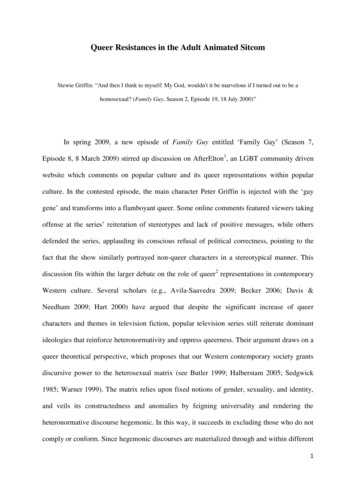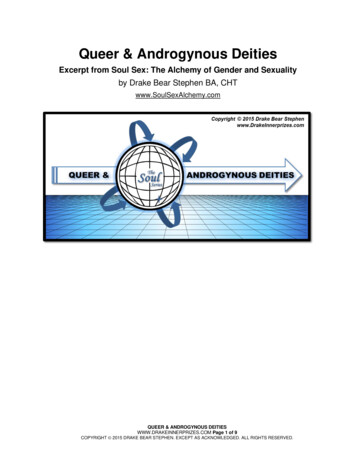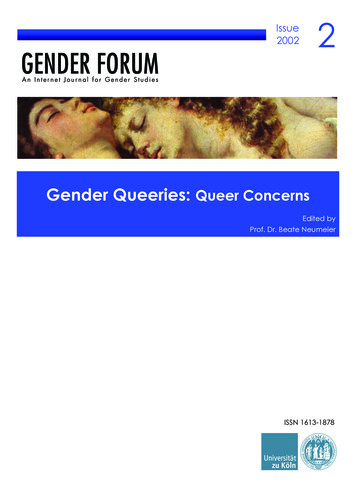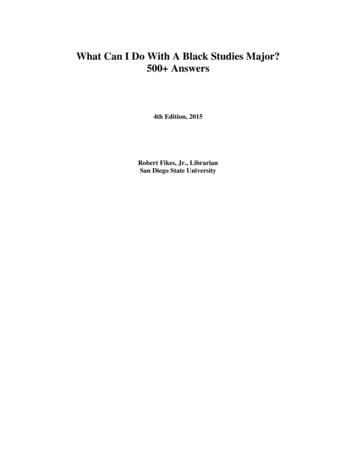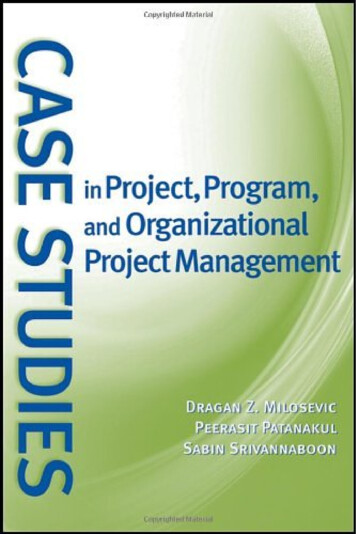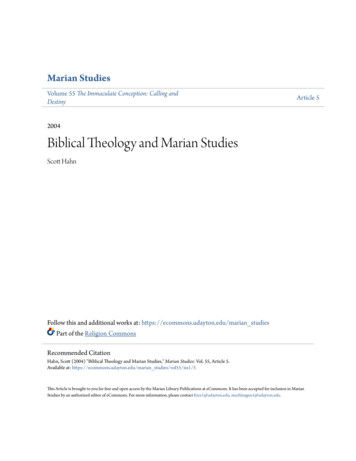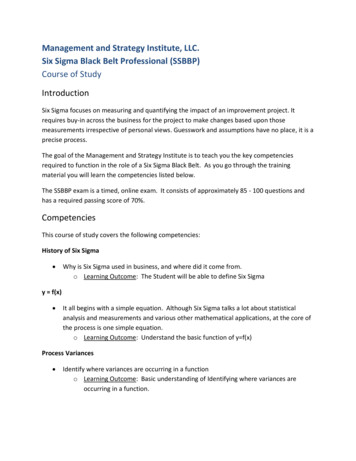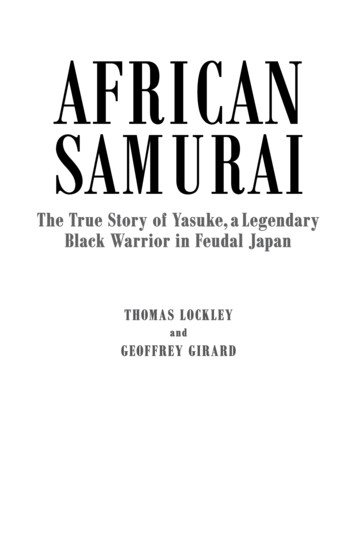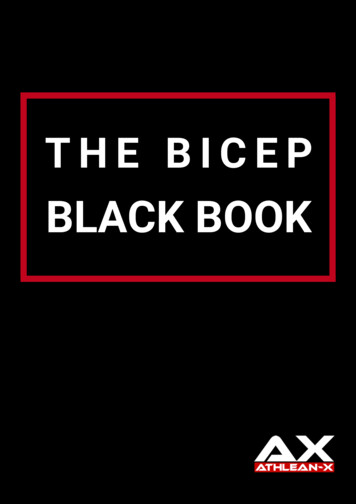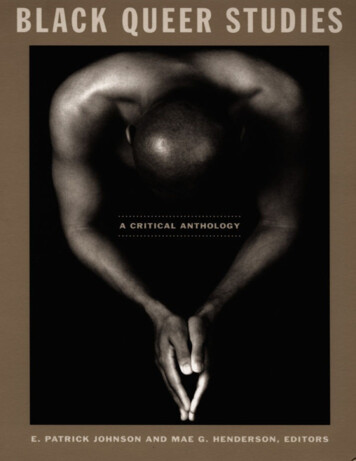
Transcription
BLACK QUEER STUDIES
BLACK QUEER STUDIESA CRITICAL ANTHOLOGY
E. PATRICK JOHNSON AND MAE G. HENDERSON,EDITORSDUKE UNIVERSITY PRESSDURHAM AND LONDON 2005
2005 Duke University PressAll rights reservedPrinted in the United States of America on acid-free paper Designed by Amy Ruth BuchananTypeset in Minion by Keystone Typesetting, Inc.Library of Congress Catalogingin-Publication Data appear on the last printed page of this book.The distribution of this book is supported by a generous grant from the Gill Foundation.
CONTENTSACKNOWLEDGMENTSFOREWORD: “HOME” IS A FOUR-LETTER WORDINTRODUCTION: QUEERING BLACK STUDIES/ “QUARING” QUEER STUDIESNOTESPART I: DISCIPLINARY TENSIONS: BLACK STUDIES/QUEER STUDIESPUNKS, BULLDAGGERS,AND WELFARE QUEENS: THE RADICALPOTENTIAL OF QUEERPOLITICS?THE EMERGENCE OF QUEER POLITICS AND A NEW POLITICS OF TRANSFORMATIONTHE ROOT OF QUEER POLITICS: CHALLENGING HETERONORMATIVITY?HETEROSEXUALS ON THE (OUT)SIDE OF HETERONORMATIVITYCONCLUSION: DESTABILIZATION AND RADICAL COALITION WORKNOTESRACE-ING HOMONORMATIVITY: CITIZENSHIP, SOCIOLOGY, AND GAY IDENTITYSOCIAL CONSTRUCTION AND THE GENEALOGY OF WHITE ETHNICITYTHE NONNORMATIVE PROPERTIES OF RACIAL DIFFERENCEHOMONORMATIVITY AND THE COHERENCE OF CITIZENSHIPTHE POLYMORPHOUS EXCLUSIONS OF HOMONORMATIVITYNOTESSTRAIGHT BLACK STUDIES: ON AFRICAN AMERICAN STUDIES,: JAMES BALDWIN, ANDBLACK QUEER STUDIESNOTESOUTSIDE IN BLACK STUDIES: READING FROM A QUEER PLACE IN THE DIASPORANOTESTHE EVIDENCE OF FELT INTUITION: MINORITY EXPERIENCE, EVERYDAY LIFE, ANDCRITICAL SPECULATIVE KNOWLEDGENOTES“QUARE” STUDIES, OR (ALMOST) EVERYTHING I KNOW: ABOUT QUEER STUDIES ILEARNED FROM MY GRANDMOTHER“RACE TROUBLE”: QUEER STUDIES OR THE STUDY OF WHITE QUEERS“YOUR BLUES AIN’T LIKE MINE”: THE INVALIDATION OF “EXPERIENCE”“QUARING” THE QUEER: TROPING THE TROPE
SEEING THROUGH QUARE EYES: READING MARLON RIGGS’S BLACK IS BLACK AIN’TBRINGIN’ IT ON “HOME”: QUARE STUDIES ON THE BACK PORCHCODANOTESPART II: REPRESENTING THE “RACE”: BLACKNESS, QUEERS, AND THE POLITICS OFVISIBILITYBEYOND THE CLOSET AS RACELESS PARADIGMBEYOND THE BODY HOMOSEXUAL: AN EPISTEMOLOGY OF RACIAL CLAUSTROPHILIABLACK FAGGOTRY BEYOND THE CLOSET NARRATIVENOTESPRIVILEGEMALE PRIVILEGESHETEROSEXUAL PRIVILEGESCONCLUSION: RESISTING PRIVILEGESNOTES“JOINING THE LESBIANS”: CINEMATIC REGIMES OF BLACK LESBIAN VISIBILITY“NOW WE THINK AS WE FUCK”: 8 AN ANTIDOTE TO INNOCENT NOTIONS“WE CALLED THEM ‘WOMEN-LOVERS”’; OR, SOME OF THE THINGS THAT ARE FORGOTTEN WHILE “THEWATERMELON WOMAN” IS “LIVING WITH PRIDE”15NOTESWHY ARE THE GAY GHETTOES WHITE?RACE AND GAY NEIGHBORHOOD FORMATION IN NEW ORLEANSCONTROLLING IMAGES OF BLACK GAY MENRACE, RACISM, CLASS, AND HOUSINGCONCLUSIONNOTESPART III: HOW TO TEACH THE UNSPEAKABLE: RACE, QUEER STUDIES, AND PEDAGOGYEMBRACING THE TEACHABLE MOMENT: THE BLACK GAY BODY IN THE CLASSROOMAS EMBODIED TEXTA STUDENT PERFORMING DRAG IN THE CLASSROOMTO TEACH OR NOT TO TEACH?NOTESARE WE FAMILY? PEDAGOGY AND THE RACE FOR QUEERNESSNOTESON BEING A WITNESS: PASSION, PEDAGOGY, AND THE LEGACY OF JAMES BALDWINNOTES
PART IV: BLACK QUEER FICTION: WHO IS “READING” US?BUT SOME OF US ARE BRAVE LESBIANS: THE ABSENCE OF BLACK LESBIAN FICTIONNOTESJAMES BALDWIN’S GIOVANNI’S ROOM: EXPATRIATION, “RACIAL DRAG,” ANDHOMOSEXUAL PANICROBERT O’HARA’S INSURRECTION: “QUE(E)RYING” HISTORYNOTESBIBLIOGRAPHYCONTRIBUTORS
ACKNOWLEDGM ENTSWe are indebted to the individuals and institutions that enabled the creation of this project. First,we would like to thank the volume’s contributors for their patience during the compilation andpublication process: their support and commitment has made the journey a smooth one. Further, thefollowing scholars were presenters at the Black Queer Studies in the Millennium conference, andwhile their work does not appear in this volume their imprint is on its final form: M. JacquelineAlexander, Lindon Barrett, Jennifer DeVere Brody, Cheryl Clarke, Jerome M. Culp Jr., Cheryl Dunye,Gerard Fergerson, Shari Frilot, Thomas Glave, Thomas A. Harris, Alycee Lane, Wahneema Lubiano,Darieck Scott, Jane Splawn, and Yvonne Welbon.We would like to thank the centers, departments, organizations, and programs at the University ofNorth Carolina at Chapel Hill that contributed resources to the conference out of which this volumeemerged, including African and African American Studies, Carolina Alternative Meetings ofProfessional and Graduate Students (CAMP), Communication Studies, Comparative Literature,Curriculum in Women’s Studies, the English Department, the Office of the Vice Provost for GraduateStudies and Research, the Sonja Haynes Stone Black Cultural Center, the Student Finance Committee,the University Program in Cultural Studies, and especially the Williamson Committee to Promote Gayand Lesbian Studies. The following individuals also contributed to making the conference a success:Renee Alexander, Kelly Gallagher, Mark Pippen, Douglas McLachlan, Glenn Grossman, TessChakkalakal, Marie Nesnow, Robin Vander, Stephen Lewis, Travaughn Eubanks, Curt Blackman,Christi Mayville, Daniel Lebold, Olateju Omolodun, Jamie Lipschultz, Gladys Jasmine, Erica Smiley,Lucy Pearce, Elizabeth Blackwood, Camille Simpson, Tiffany Foster, Kim Curtis, David Roberts,Karolyn Tyson, Joanna Muster, Chandra Ford, Kelly Rowett, Jules Odendahl, Doug Taylor, andRachel Hall.Many friends and colleagues gave their support at various stages of the project. Special thanksgoes to Cedric Brown, Dwight Conquergood, Sandra Richards, and Cheryl Wall.Special thanks to Darlene Clark Hine and the Department of African American Studies atNorthwestern University who provided funding to publish this volume.We are deeply indebted to Ken Wissoker, editor-in-chief at Duke University Press, for staying thecourse and supporting this project. We would also like to thank the production staff at the Press fortheir professionalism, helpfulness, and diligence.Finally, we thank Stephen Lewis, who always manages to step in in the nick of time.
FOREWORD:“HOM E” IS A FOUR-LETTER WORDSHARON P. HOLLANDThe editors of this volume deploy the term “interanimation” to describe the intellectual dynamic atplay in the essays’ various musings. I can think of no better word or way to describe both thiscollection and my experience of its genesis. In April 2000, I traveled to North Carolina to witness anunprecedented event: the field in which I had been laboring since my junior year at Princeton wasnow coming of age. I moved toward a space that attempted to define a connection between “black”and “queer” at a time when “queer” had its own controversial orbit. Would “queer” obfuscate thepresence of lesbians in a movement that, although “grounded in social and political activism,”according to the editors, had its own specific historical struggle over the “inclusion” of women in thestory of itself ? The academic market, at least its emerging “queer” constituency, seemed to beinterpreting “identity politics” as the root of all evil—simply get rid of “race” (always a fiction?) andthe category of “woman” (already a misnomer?) and we would have our rebirth on the other side ofour problem(s).While “queer” studies began to define its origins from the complex remaking of identity politics,those of us already working in the field of black feminism found this “new” trajectory unsettling—scholars like Hazel Carby and Hortense Spillers had already unseated the idea of “woman” as auniversal category; Gloria Hull, Barbara Smith, and others had already questioned the myopicidentity politics of civil rights and women’s activist networks. The question hardly seemed “new” tous at all, but rather more of the same: remaking discourse in the image of its rightful owners—whitewashing the product so that it could and would be more palpable to a growing constituency.Been there, done that. The present tension in the fields of feminist, ethnic, and queer studies remindedme of a talk I once heard while I was an assistant professor at Stanford. During this talk, a renownedscholar of the history of academic institutions and forms of knowledge production tried to explain thepressures brought to bear on English departments in the last decade of the twentieth century in termsof capital and interdisciplinarity. When my colleague in African American studies challenged him byrecalling the formation of African American and Women’s studies programs and the kind of bodiesthat those disciplinary “homes” brought to the academy, he seemed puzzled and rather annoyed. Hemistook her challenge as personal and emotional (identity politics) rather than as intellectual. It was amisunderstanding that taught me a valuable lesson about the way that “race” and “gender” really workin the academy. I still find that rather than listen to what I am actually saying, colleagues will oftensee me—black, woman, lesbian—and have very high expectations for the kind of narrative that Imight employ. Often, they run that tape simultaneously with my voice, so that the din of the taped
voice is louder than my own. We have a script that colleagues expect us to deliver, and when we donot the damage is twofold: “How dare you not live up to my expectations” couples with the kind ofshame that colleagues manifest when they realize that in order to argue with you, they would have hadto listen to you in the first place. Since the latter is an embarrassing moment for speaker and audience,the deadlock is dead space.I traveled to Chapel Hill, North Carolina, knowing that I would share space—at least for threedays—with scholars who know that moment, who’ve felt its force. I wasn’t expecting “home” and asthe weekend progressed, so many of us testified to the bittersweet affect of that remedy. For me inparticular, it was more bitter than sweet because the conference would return me to my family seat, asnearby Durham was “home” for my mother’s people. My estrangement from my biological family hadendured for thirteen years, so that when my plane landed at Raleigh-Durham airport, I felt like a thiefin the night. As I trespassed upon a place that was no longer “home” for me, I walked into anintellectual space that was also a fraught location for my own “identity politics.” The queer pleasurewas overwhelming—that weekend, I loved Durham with a vengeance.What I found at the Black Queer Studies in the Millennium conference was a group of colleaguesinterested in the “messiness” of it all. Each panel presented questions and challenges for thediscipline(s) and for “blackness.” Moreover, it taught us how to talk to one another—how to disagreein public, even though the stakes of that disagreement were and are so high. For us, blackness had alimit and a shape, shortcomings and advantages. As E. Patrick Johnson and Mae G. Henderson note,“we want[ed] to quare queer, throw shade on its meanings.” And throw shade we did—it was abeautiful thing.With the memory of that particular moment in mind, the editors of this volume, wittingly orunwittingly, group the essays in each section around an important intellectual moment in theconference. In this sense, this collection is a gift, a re-memory, for those of us who witnessed itspower: the good, the bad, and at times, the ugly. For scholars new to the field, it provides aninvaluable chronicle of an emerging field of inquiry—one that has its shape as the new queer of colorcritique, pace José Muñoz and Roderick Ferguson, to name only two. As scholars move everincreasingly toward issues of globalization and U.S. imperialism, the essays collected hereunabashedly focus on the Americas as a specific site—as a place where black peoples have and stillexperience the force of this country’s perpetual attempt to increase its borders and its reach.Because hindsight is always dangerous, I will not critique what is missing from this collection, butrather only describe its missed opportunities as a kind of melancholia—the symptom always in searchof dis-ease. What the collection does not and cannot articulate is the tension that arose between thosewho produce “culture” and those who consider themselves the arbiters of its critical reception. Whilemany of us have considered the line between critic and culture to be porous, we quickly learned thatthere are important and salient differences between the two. Ironically enough, this tension alsohelped to obfuscate another typical division—that is, it failed to reproduce a now-familiar conferencescene where “activists” and “academics” square off like gangstas in a B movie. Instead, the frictionbetween critics and filmmakers, journalists and theorists, was focused on the intellectual endeavorbefore us—simultaneously demonstrating the importance of our efforts and the necessity for theconference itself. Black Queer Studies in the Millennium still remains one of the only conferences Ihave attended where activists and academics weren’t encouraged to rip each other to shreds. It wasobvious in the conference auditorium—at least for that weekend—that we needed one another tocomplete the discourse, to do the work.E. Patrick Johnson’s solo performance at the end of a long Saturday articulated the drama of that
weekend and the necessity of cultural production. It brought many of us back to the beginning—at onepoint we were all little black boys and girls who knew that we were “quare” and that we couldn’thide it. Like Morrison’s classic line “eruptions of funk”—our quareness exploded upon the ordinarylife of childhood and made family and friendship all the more difficult, morphing them into thebittersweet tonic that many of us now refer to as “home”—a place of refuge and escape. Ourquareness also brought many of us to the public library and ultimately to the university as wesearched for reflections of ourselves and began to find them tucked away in the Harlem Renaissance,embedded in second-wave feminism, and nestled at the heart of the civil rights struggle. The more wesaw, the more we understood ourselves as backbone r
Darieck Scott, Jane Splawn, and Yvonne Welbon. We would like to thank the centers, departments, organizations, and programs at the University of North Carolina at Chapel Hill that contributed resources to the conference out of which this volume emerged, including African and African American Studies, Carolina Alternative Meetings of Professional and Graduate Students (CAMP), Communication .
